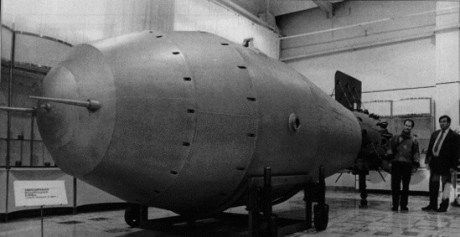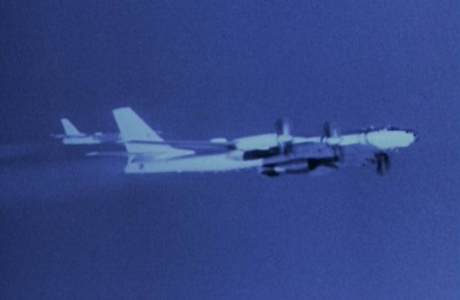At the height of the Cold War, a year before the Cuban missile crisis, the Russians created the largest bomb ever created by man. The shock wave from the explosion, which had a force of 50 megatons, circled the Earth three times

October 30, 1961. In the gray sky of the "Novia Zemlya" archipelago, not far from the "Mityosha" bay, a large bomber appeared with a strange bump on its roof. At 11:29, in Moscow, thousands of kilometers away, the order was given to release the cargo. The object, whose fall is slowed down by a large parachute, begins its fall, while the plane moves away from the place at maximum speed.
188 seconds later, at an altitude of about 4000 meters, a flash of light was created that could be seen at a distance of up to 1000 km. An orange fireball began to swell rapidly, until it reached a massive size of several tens of kilometers in diameter. Heat was felt more than 200 km away. It was the most powerful explosion ever created by man.
"Kozkia's mother"
The super-bomb test, like most of the nuclear tests of the period, was conducted for political considerations of the Soviet leadership at the time, and especially of the chairman of the Communist Party - Nikita Khrushchev. On July 1961, XNUMX, in a meeting with the "atomic scientists" - the senior scientists in the USSR's nuclear program - Khrushchev ordered the execution of a series of large nuclear experiments, which would culminate in the construction and operation of a nuclear device of unprecedented power. The main goal was "to show the (American) imperialists what the Soviet Union is capable of".
In fact, work on high-powered nuclear devices had already been carried out several years before you. In June 1956, a report was published regarding the creation of a thermonuclear bomb with a large power of several tens of megatons. Some parts of the device, which received the code name "product number 202", including the parachute system, were used by the creators of the bomb in 61. In addition, there were several projects based on such bombs.
But let's go back to July of sixty-one. At the beginning, it was decided to build a bomb with a power of 100 megatons - many times more than any previously designed device. The best scientists in their field were chosen for the group of developers who received the instruction - Andrei Sakharov, Yuri Babayev, Victor Adamsky, Yuri Trotnev and Yuri Smirnov. The task before them was extremely complicated - no one had ever created a device with such great power and in such a short time. According to Khrushchev's plan, the experiment should have been conducted in October, in preparation for the opening of the 22nd Congress of the Party - a first-class political event in the USSR, where they used to brag about the achievements of socialism.
He headed the team for about 120 days. Every aspect, both mathematical and engineering, was done as quickly as possible, and design changes were made at the same time as the bomb was being built. In August, in order to reduce the intensity of the explosion and the amount of nuclear fallout, it was decided to change the intensity of the bomb to 50 megatons. It was not an easy step, because Khrushchev had already publicly mentioned the number 100, but the dangers were too many. And so, two months from the date of the test, the structure of the super-bomb was changed.
For the first time in the history of the USSR's nuclear tests, the date and details of the test were published in advance, and openly. Khrushchev's statement about the bomb that the USSR was going to detonate put even greater pressure on the scientists. There was no room for error, "failure is not an option". The Stalin period, in which mistakes were paid for with life or freedom, has already ended, so there was no threat to them, but the honor of the entire USSR was on their shoulders and they had to succeed. As Sakharov told his team, "If we don't succeed, we'll all go build railroads."
In one of his last speeches, he said that the USSR "will show the Americans the mother of Kuzkina Mat" (Kuzkina Mat) - a Russian phrase meaning "to punish strongly". The translation they received in the West was "Kuzma's mother" (Kuzma), so it remains unclear who the "Kuzma" is and why he should be feared. In the USSR itself, the phrase of the party chairman has become almost legendary, and the bomb is sometimes referred to as "Kozkia's mother shown by Khrushchev".
Ivan the Great
The construction of the bomb was conducted at the secret site "Chelbinsk-70", near the city of Sanzhinsk. The assembly was done directly on the railway tracks, in order to facilitate the transport. The construction of the warhead itself, which received the code name "product number 602", was done at another secret site, "Arzamas-16", in the Ural Mountains. There, the bomb received the affectionate name "Ivan", which the developers gave it.
"Ivan" was a thermonuclear bomb, or in a more popular term - a "hydrogen bomb". In such bombs, a process of nuclear fusion is used, in which two atoms of light elements fuse into heavier atoms. In this process much more energy is emitted than in the process of nuclear fission, on which a normal, "atomic" nuclear bomb is based. But in order to sustain the fusion reaction, several conditions are needed, such as very high temperature and pressure. This is obtained by creating a normal nuclear explosion. That is, an atomic bomb is used to "ignite" the hydrogen bomb itself.
Ivan had a three-stage structure. In an approximate way, it can be said that the normal nuclear phase ignited the first thermonuclear phase, which in turn ignited the second thermonuclear phase. The "tanks" that hold the thermonuclear fuel can be made of enriched uranium, which will ensure the doubling of the power, but this has a significant drawback - the higher the percentage of energy obtained from the normal nuclear reaction, the greater the fallout. A thermonuclear reaction, on the other hand, is much cleaner. Therefore, after Sakharov decided to reduce the power and replaced the uranium with lead, Ivan became the "cleanest" bomb ever, in terms of percentages - 97% of its energy comes from the process of nuclear fusion.
The size of the super-bomb was, without a doubt, impressive - a weight of about 27 tons, a length of 8 meters, and a diameter of about 2 meters. The weight and dimensions made it very difficult to transport the bomb, and to prepare it for detonation. The only aircraft that could have lifted the bomb was the Tu-95V heavy bomber, which had been developed a few years earlier, specifically for carrying large nuclear bombs. Because of the size of "Ivan" they had to take down a significant part of the bomb bay and make changes to the structure. But even then the bomb stuck out - something that had a negative effect on the plane's properties. In order to stabilize the bomb during its fall and give the pilots time to move away from the point of explosion, a special system of parachutes was needed that extended over a huge area of about 1600 square meters and even required a lot of effort from the nylon industry of the USSR.
In addition to the bomber with the bomb itself, there was also an escort plane, a Tu-16A with measuring and photography equipment, in the area. Both were covered with a special white paint to protect them from radiation. The bomb was dropped from a height of 10500 meters, when the barometric pressure sensors activated the explosive at a height of about 4000 meters. The difference in altitude left the pilots about three minutes from the moment the bomb was dropped.
 The Tu-95V bomber with the special payload. Photo: Government Archives
The Tu-95V bomber with the special payload. Photo: Government Archives
The explosion
On the morning of October 30, 1961, the Tu-95 bomber, with the serial number 5800302, took off from the "Olanay" airport, on the Kola Peninsula, in northern Russia. On board was a crew of 9 people, under the command of Major Andrei Dornovtsev, who after the successful test is He was promoted to the rank of lieutenant colonel and received the letter "Hero of the USSR". The weather was cloudy, visibility was at a distance of 10 km, and after a flight of a little more than two hours, the plane arrived at the "Sukhoi Nuss" test site, in the area that produces "Matuchkin Shaar".
The explosion happened at 11:33 Moscow time, when the plane was about 40 km from Ground Zero. A very strong flash of light lasted thirty seconds. According to some estimates, the destruction of buildings could have taken place at a distance of more than 100 km. Third degree burns could be received at a distance of 60-70 km, eye damage - 200 km. The impact was felt on Dixon Island, which is about 700 km away. From the intensity of the explosion, which was estimated to be one percent of the intensity of the sun's radiation(!), the shock wave circled the earth three times.
According to American estimates, the actual force of the explosion was closer to 60 megatons than the fifty that appeared in the Russian sources. The USSR did not deny this, because any great assessment, justified or not, served its purposes. The creators of the bomb received most of the information, as well as the photographs of the explosion, from the escort plane, which was a little more than 50 km away. At such a distance all the buildings were destroyed, but the shock wave reached the planes when they were more than a hundred kilometers away, so they were not damaged.
Radio contact with Nubia Zemlya ceased for 40 minutes due to the background radiation caused by "Ivan". And it was the silence in the connection through which they realized in Moscow that the explosion did happen. They learned about the complete success later, when the initial data was received on the size of the well-known mushroom cloud, which reached a height of more than 60 km and was visible from a distance of 800 km.
 The largest man-made explosion in history. Photo: Government Archives
The largest man-made explosion in history. Photo: Government Archives
The legacy of the Tsar
In the West, the Soviet super-bomb was called "Tsar Bomba". The nickname comes from several Russian inventions that were huge in size but not useful, such as the "tsar-bell" that never rang or the "tsar-cannon" that fired once. In contrast to these two, "Ivan" worked excellently. It is no secret that the bomb was not an effective weapon, and perhaps not even a military weapon at all - its large dimensions prevented it from being carried over long distances, the resources needed to create it were as enormous as its physical size, and what is most paradoxical - there were almost no targets worthy of its destructive power.
First and foremost, there was a super-bomb of the USSR as a result of the hard work and heroism of the people who developed and tested it. No one has created anything similar before you, and Sakharov and his team performed the complicated work in a very short time. The achievement in the explosion was not military but scientific-technological. There were several theoretical projects that used a nuclear bomb of such power, but none of them were implemented. One of the best known is a project by Sakharov himself, who in 1952 proposed to build a torpedo (T-15) with a nuclear warhead with a power of 100 megatons, to create huge tsunami waves that would destroy the cities along the US coast, but the project was canceled by The army
It is doubtful whether even the leadership saw the "Tsar Bomba" as a useful weapon. It was more of a political weapon, an ostentatious threat in the direction of the USA and the capitalist countries. Khrushchev himself saw the bomb as proof of the technological and ideological superiority of the USSR. These were the days of the Cold War, a year before the Cuban Missile Crisis, and showing capabilities in the field of nuclear weapons was a first-rate propaganda tool.
In conclusion, although the explosion itself took place in Nubia Zemlya, the "shock" was also felt in Washington. In fact, it is possible that the "echoes" from this event, which happened exactly 45 years ago, we can still feel today.
Semyon Semyonov writes on the "Target: Space" blog on a focused coverage website.

15 תגובות
Ofer
And millions of people were saved thanks to this experiment.
Millions of stocks were destroyed with the explosion, the whole purpose of which was "Shuponi". A low moment for man and science.
Excellent article, I really enjoyed reading it, very detailed. Thanks
I wonder if there is a study that examines the incidence of cancer cases from the time of the experiment until today
Logic says that if the shock wave circled the earth three times, every form of life may have been contaminated by radioactive radiation, and this can explain the abnormal statistics of patients all over the world, after all, a hundred years ago cancer was a rare event among the population and today it is very common.
It only takes one more small step to destroy all of humanity in one blast
I wonder if this is what made Andrey Sakharov change his mind and become an opponent of nuclear weapons and a human rights activist?
You probably need a bomb of such power to bring a person down from the hubris in which he lives, after all he had no problem as stated in the article to build a facility that would create tsunami waves.
Were there any casualties in the explosion?
Can anyone say what the climatic and environmental effects of the nuclear tests in general and of this bomb in particular?
Is there a certain threshold that if crossed would result in a disaster on a global scale?
After all, there have been volcanic eruptions in the past that caused mass extinctions and some of them were of an order of magnitude not much larger than the bomb in question...
And if you don't believe me, I looked for a source for you that even happens to compare the danger of asteroids to the experiment in question:
"Based on crater formation rates determined from the Earth's closest celestial partner, the Moon, astrogeologists have determined that during the last 600 million years, the Earth has been struck by 60 objects with a diameter of five kilometers or more. The smallest of these impactors would release the equivalent of ten million megatons of TNT and leave a crater 95 kilometers across. For comparison, the largest nuclear weapon ever detonated, the Tsar Bomba, had a yield of 50 megatons.”
http://en.wikipedia.org/wiki/Impact_event
Check what you say before you post
owl, where did you get your scientific "knowledge"?
First of all, let's start with the fact that no one claimed that more energy was released than planned. The US simply claims that the bomb was designed to release about 60 megatons and not as the Russian scientists had published before (although they later did not try to deny it - whether the US was right or whether this claim contributed to propaganda).
And the second thing, most important of all, in history like DHA many asteroids hit and the energy of the impact released energy several orders of magnitude greater and so far the hydrogen in the atmosphere has not been "ignited"... So where did you get the scientific knowledge that created new physics?
As far as I know the difference between the 50 megatons planned by the Russian scientists and the 57-60 megatons measured after the explosion by the USA was created because the hydrogen in the atmosphere with the help of the explosion was also "melted" in the explosion, in addition there are scientists today who estimate that if The explosion would have been carried out in the original size of 100 megatons, this would have caused the creation of a chain reaction that could have caused a significant portion of the hydrogen in the Earth's atmosphere to "burn"
To the guys from science -
It would be nice if you would add a link to a YouTube site with videos of the bomb explosion - there are a lot of good quality videos and this could give the site a nice "spice".
Successfully !
How there was no radiation
Very interesting and detailed article, yes Yarivo!